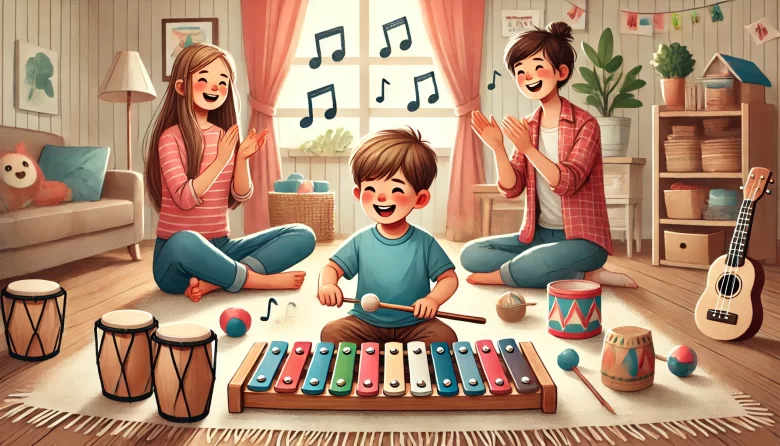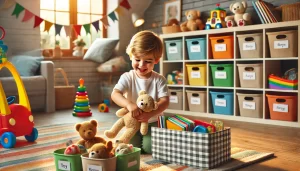Music plays a vital role in a child’s early development. It helps improve memory, enhances language skills, and even boosts emotional well-being. Best of all, you don’t need to be a professional musician to incorporate music into your child’s learning at home!
In this article, we’ll explore the benefits of music in early childhood education and provide simple, fun ways to use music to support your child’s development.
Why Is Music Important for Early Childhood Learning?
Music affects multiple areas of a child’s brain development. Here’s how:
- Language Development – Singing songs and listening to lyrics help children learn new words, sentence structures, and pronunciation.
- Memory and Cognitive Skills – Music strengthens memory by reinforcing patterns and sequences.
- Emotional Expression – Children can express their feelings through music, whether by singing, dancing, or playing an instrument.
- Motor Skills – Playing simple instruments or dancing to music improves coordination and fine motor skills.
- Social Skills – Singing along with others encourages teamwork, listening, and cooperation.
Now, let’s explore how you can incorporate music into your daily routine!
Singing Simple Songs
Best for: Language development and memory
Singing is one of the easiest ways to introduce music into learning. Try:
- Nursery rhymes like Twinkle, Twinkle, Little Star and The Wheels on the Bus.
- Making up songs about daily routines (e.g., brushing teeth, getting dressed).
- Encouraging your child to create their own lyrics to familiar melodies.
Singing reinforces words and phrases, helping children expand their vocabulary in a fun, stress-free way.
Rhythm and Clapping Games
Best for: Motor skills and coordination
Clapping to a beat helps children understand rhythm and improves motor skills. Try:
- Clapping along to songs together.
- Playing “repeat the rhythm” games where your child mimics the beat you clap.
- Using pots, wooden spoons, or simple drums to experiment with beats.
These activities develop a child’s sense of timing and coordination while making learning interactive.
DIY Musical Instruments
Best for: Creativity and fine motor skills
You don’t need expensive instruments to explore music. Create simple instruments at home:
- Shakers: Fill small plastic bottles with rice or beans.
- Drums: Use empty containers or pots with wooden spoons.
- Guitar: Stretch rubber bands over a shoebox.
Encourage your child to explore different sounds and rhythms. Making their own instruments also strengthens fine motor skills and creativity!
Dancing to Music
Best for: Gross motor skills and self-expression
Put on music and let your child move freely! Dancing helps:
- Improve coordination and balance.
- Strengthen muscles and develop body awareness.
- Encourage self-expression and confidence.
For extra fun, play a freeze dance game—stop the music randomly, and your child has to freeze in place!
Using Music for Storytelling
Best for: Imagination and comprehension
Music can make stories more engaging. Try:
- Playing soft background music while reading a story.
- Encouraging your child to add sound effects (e.g., stomping for a giant, clapping for rain).
- Singing parts of the story to make it interactive.
Adding music to storytelling enhances imagination and keeps kids engaged.
Teaching Numbers and Letters with Music
Best for: Early literacy and math skills
Songs make it easier for children to remember letters and numbers. Try:
- Singing the ABC Song to reinforce letter recognition.
- Using counting songs like Five Little Ducks or Ten in the Bed.
- Clapping or tapping to count beats, helping with early math concepts.
Music makes learning abstract concepts like numbers and letters more tangible and enjoyable.
Relaxation and Sleep with Music
Best for: Emotional well-being and bedtime routines
Soft, calming music can help children relax and prepare for sleep. Try:
- Playing gentle lullabies at bedtime.
- Using nature sounds or instrumental music for a calming effect.
- Singing a bedtime song as part of the nighttime routine.
Music provides comfort and helps regulate emotions, making transitions like bedtime smoother.
Exploring Different Musical Genres
Best for: Cultural awareness and active listening
Introducing children to different musical styles helps expand their understanding of the world. Try:
- Playing classical music, jazz, folk songs, or world music.
- Discussing how each type of music makes them feel (happy, calm, excited).
- Encouraging them to move differently depending on the rhythm.
Exposure to various genres builds an appreciation for music and enhances listening skills.
Making a Family Band
Best for: Social skills and teamwork
Creating a family band encourages collaboration and creativity. Try:
- Assigning everyone a simple instrument (real or homemade).
- Taking turns leading the rhythm or choosing a song.
- Singing together to promote teamwork and confidence.
This activity strengthens family bonds while improving musical awareness.
Sound Exploration and Outdoor Music
Best for: Sensory development and curiosity
Encourage children to listen to the sounds around them. Try:
- Going outside and identifying sounds (birds, wind, cars, footsteps).
- Using objects like sticks, rocks, or leaves to create rhythms.
- Recording different sounds and playing a guessing game.
This type of musical play helps kids become more aware of their surroundings and enhances auditory skills.
Final Thoughts
Music is a powerful tool that supports language development, cognitive skills, emotional expression, and motor coordination. By incorporating singing, rhythm games, dancing, and simple instruments into your daily routine, you can create a fun and enriching learning environment at home.
Try these activities and watch your child’s love for music—and learning—grow! 🎶




